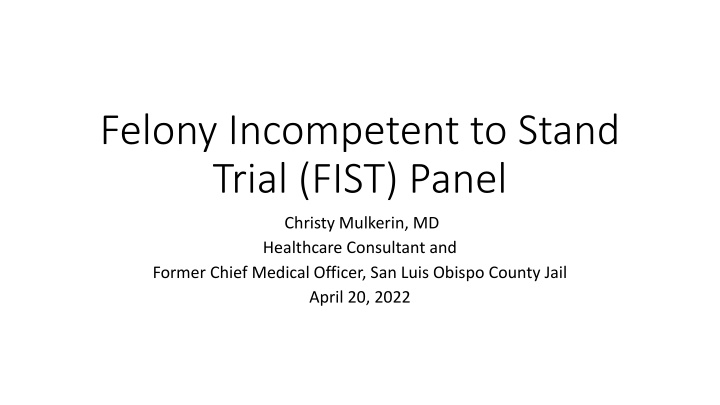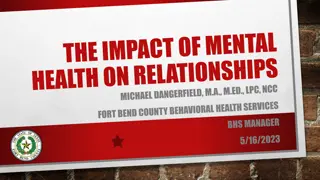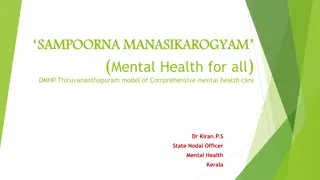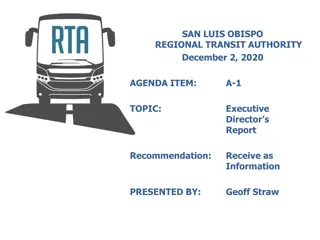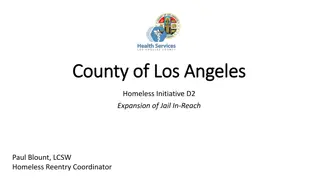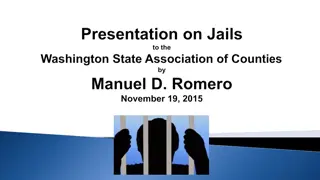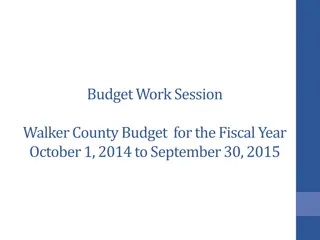Ensuring Mental Health Care in San Luis Obispo County Jail
Healthcare initiatives in San Luis Obispo County Jail aim to improve mental health services, focusing on FIST patients and reducing recidivism. Efforts include the Stepping Up Initiative, JBCT programs, and partnerships with DSH for support.
Download Presentation

Please find below an Image/Link to download the presentation.
The content on the website is provided AS IS for your information and personal use only. It may not be sold, licensed, or shared on other websites without obtaining consent from the author.If you encounter any issues during the download, it is possible that the publisher has removed the file from their server.
You are allowed to download the files provided on this website for personal or commercial use, subject to the condition that they are used lawfully. All files are the property of their respective owners.
The content on the website is provided AS IS for your information and personal use only. It may not be sold, licensed, or shared on other websites without obtaining consent from the author.
E N D
Presentation Transcript
Felony Incompetent to Stand Trial (FIST) Panel Christy Mulkerin, MD Healthcare Consultant and Former Chief Medical Officer, San Luis Obispo County Jail April 20, 2022
San Luis Obispo (SLO) County Population 283,000 Central Coast of California Jail: Average Daily Population 450 (down from 550-600 prior to COVID) County focus on Jail healthcare started in 2017 after the death of an inmate with serious mental illness Chief Medical Officer position created in 2018 Healthcare switched from County-run to Wellpath in 2019
5 years ago Long waitlist for DSH across California Medication compliance for FIST patients was poor Patients decompensated while waiting Staff did not have many tools San Bernadino Jail Based Competency Treatment Program had begun
Stepping Up Initiative Effort to reduce the number of people with mental illness in Jails (1) Reduce the number of people booked into Jail Decrease arrests, Community treatment (2) Decrease length of stay Improve medication compliance and treatment options Mental Health Diversion, JBCT, Specialty housing in Jail (3) Reduce recidivism (4) Increase connections to treatment Cal-AIM, in-reach, housing, MH Diversion
2 years ago Healthcare transition completed New 5-bed JBCT program full Involuntary medication orders administered when needed DSH waitlist small Kansas Max specialty housing unit created Behavioral Health Incentive Program Mental Health Diversion program up and running (Department of Justice Investigation)
1 year ago Jail population down due to de-incarceration efforts COVID outbreaks resulting in limited transfers to DSH and prison Percentage of Jail population with serious mental illness has doubled (to 25% or 100 patients) JBCT Program full DSH waitlist growing locally and across the State Acceptance into diversion difficult because of medication compliance Turned to DSH for ideas and support
Shift in focus: treat, stabilize and transition to community Despite our efforts, our patients with SMI are increasing Waitlists, COVID stress, homelessness, charges What do we do while they wait for restoration? Early involuntary medication order implementation Long-acting injectable psychotropic medications Diversion and Jail restoration How do we keep people from coming back? Diversion and community treatment Emphasis on re-entry planning
FIST Solutions Workgroup Nobody believes that these people belong in Jail Unfortunately, that is where they are Whose responsibility is it to take care of these patients? State? Counties? Where should we build capacity to care for them? Community? Jail? Department of State Hospitals? How can we support Jails? Jails currently have the hard task of taking care of these patients Many Jails have few tools There is aversion to adding funding to the Jails in the long-term DSH support at the local level
Questions? Thank you! Christy.Mulkerin@gmail.com
